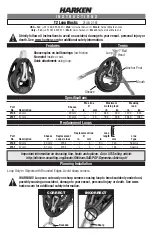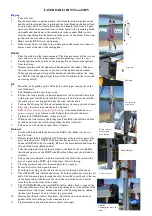
Velp Scientifica
– UDK139 Operating Manual
10004762/B5
66
Steam distilled ammonia can be collected with the condensate from the water cooled
condenser in two different ways:
a)
in a classical solution of sulphuric acid of known titre and following back-titration.
b)
more recently, by a solution 4% of boric acid (H
3
BO
3
). Boric acid is practically un-
dissociated and allows direct titration of alkali (ammonia) by strong acids of known
titre.
Indicator solutions
A volume of 125-130 ml of solution to be titrated requires 10 drops about of indicator
solution.
a)
for a back-titration of sulphuric acid with Sodium hydroxide: 20 - 30 mg of methyl
red in 100 ml of water; colour change from red to yellow at pH 4.9.
Or: 100 mg of bromocresol green and 30 mg of methyl red in 100 ml ethyl alcohol
96%; colour change from red to green at pH 4.5.
b)
titration by sulphuric or hydrochloric acid of ammonia absorbed by boric acid
solution.
Tashiro's indicator: 0.6 g of methyl red are dissolved by 50 ml of 95% ethyl alcohol
and then added to a methylene blue solution (0.1 g in 50 ml of distilled water).
The colour is green in alkaline range and gray to pink (pH 4.9) in acid medium to red
with an excess of acid.
Potentiometric titration
It can be performed by using N/50 HCl and an end point of pH 4.7. The low
dissociation of boric acid allows direct titration of alkali (ammonia).
Colorimetric determination
Besides titration, ammonia nitrogen determination can be performed by colorimetric
methods, for example:
1.
Method 417 B. Nesslerization or Method 417 C. Phenate: Standard Methods for
the Examination of Water and Wastewater. 16th Edition.
APHA-AWWA-WPCF. Washington D.C. 1985.
2.
Method D 1426. Ammonia nitrogen. Book of Standards ASTM. Part. 23.
Water and Atmospheric Analysis. Philadelphia. 1983.
3.
Analytical kits for water. Available on request.
In any case the ratio between weight or volume of sample and volume of distillate
used for ammonia determination must be taken into account.
Calculation
It is commonly agreed that protein content is obtained multiplying by 6.25 the weight
of Nitrogen obtained by the Kjeldahl method. This corresponds to consider all
proteins as composed by 16% Nitrogen.
As a matter of fact protein composition ranges from 15 to 18% Nitrogen.
This accounts for other factors, sometimes used, different from 6.25, generally lower.
AOAC suggests for specific products the following factors: 5.18 for almonds; 5.30 for
coconuts and other tree nuts, 5.46 for peanuts and Brasil nuts; 5.70 for wheat flour;
6.38 for milk and dairy products (official Methods of Analysis (1984). Association of
Official
Analytical
Chemists.
Arlington,
VA-USA).
FAO-WHO (1973) propose factor 5.70 for wheat meal and soy.
253
















































